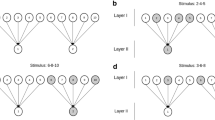Abstract
Cerebral lateralization refers to the poorly understood fact that some functions are better controlled by one side of the brain than the other (e.g. handedness, language). Of particular concern here are the asymmetries apparent in cortical topographic maps that can be demonstrated electrophysiologically in mirror-image locations of the cerebral cortex. In spite of great interest in issues surrounding cerebral lateralization, methods for measuring the degree of organization and asymmetry in cortical maps are currently quite limited. In this paper, several measures are developed and used to assess the degree of organization, lateralization, and mirror symmetry in topographic map formation. These measures correct for large constant displacements as well as curving of maps. The behavior of the measures is tested on several topographic maps obtained by self-organization of an initially random artificial neural network model of a bihemispheric brain, and the results are compared with subjective assessments made by humans.
Similar content being viewed by others
References
Bianki, V. L. (1993). The Mechanisms of Brain Lateralization. Gordon and Breach.
Bookstein, F. (1991). Morphometric Tools for Landmark Data. Cambridge: Cambridge University Press.
Bookstein, F. (1996). Biometrics, biomathematics and the morphometric synthesis. Bull. Math. Bio. 58, 313–365.
Davidson, R. J. and K. Hugdahl (1995). Brain Asymmetry, MIT: MIT Press.
DeMott, D. (1970). Toposcopic Studies of Learning, Charles C. Thomas.
DeYoe, E., et al. (1994). Multiple processing streams in occipitotemporal visual cortex. Nature 371, 151–154.
Galaburda, A. and M. Habib (1987). Cerebral dominance: biological associations and pathology, Discuss. Neurosci. 4, FESN.
Goodall, C. (1991). Procrustean methods in the statistical analysis of shape, J. R. Statis. Soc. B53, 285–339.
Hardy, G., J. E. Littlewood and G. Pólya (1991). Inequalities. 2nd edn, Cambridge: Cambridge University Press.
Hellige, J. B. (1993). Hemispheric asymmetry. Harvard: Harvard University Press.
Kaas, J. (1991). Plasticity of sensorimotor maps in mammals. Ann. Rev. Neurosci. 14, 137.
Knudson, E., S. du Lac and S. Esterly (1987). Computational maps in the brain. Ann. Rev. Neurosci. 10, 41–65.
Kohonen, T. (1995). Self-Organizing Maps. Berlin: Springer-Verlag.
Kosslyn, S., M. Sokolov and J. Chen (1989). The Lateralization of BRIAN: A computational theory and model of visual hemispheric specialization, in Complex Information Processing: Impact of Herbert A. Simon D. Klahr and K. Kotovsky (Eds), Erlbaum.
Levitan, S. and J. Reggia. (1998). A computational model of lateralization in cortical maps, submitted.
Lezak, M. D. (1995). Neurological Assessment. Oxford: Oxford University Press.
Martin, A., et al. (1996). Neural correlates of category-specific knowledge. Nature 379, 649–652.
Merzenich, M., et al. (1983). Topographic reorganization of somatosensory cortical areas 3b and 1. Neurosci. 8, 33–55.
Nudo, R., et al. (1992). Neurophysiological correlates of hand preference in primary motor cortex of adult squirrel monkeys. J. Neurosci. 12, 2918–2947.
Pascual-Leone, A., E. Wassermann and N. Sadato (1995). et al., The role of reading activity on the modulation of motor cortical outputs. Ann. Neurol. 38, 910–915.
Pearson, J., L. Finkel and G. Edelman (1987). Plasticity in the organization of adult cerebral cortical maps: a computer simulation, J. Neurosci. 7, 4209–4223.
Sprott, D. A. and M. P. Bryden (1983). Measurement of laterality effects, in Cerebral Hemisphere Asymmetry J. B. Hellige (Ed.), New York: Praeger.
Sutton, III G.G., J. A. Reggia, S. Armentrout and C. L. D’Autrechy. (1994). Cortical Map Reorganization as a Competitive Process, Neural Computation 6, 1–13.
Author information
Authors and Affiliations
Rights and permissions
About this article
Cite this article
Alvarez, S.A., Levitan, S. & Reggia, J.A. Metrics for cortical map organization and lateralization. Bull. Math. Biol. 60, 27–47 (1998). https://doi.org/10.1006/bulm.1997.0002
Received:
Accepted:
Issue Date:
DOI: https://doi.org/10.1006/bulm.1997.0002




